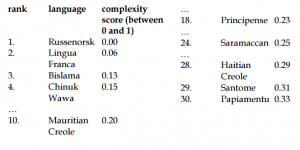To answer this question, Parkvall (2008) examines 53 WALS (The World Atlas of Linguistic Structures) features which reflect degrees of complexity, and codes them additionally in 29 pidgins and creoles, comparing the degree of complexity of these creoles with 153 non-creoles of the WALS sample. 18 main features were used (a subset of Parkvall’s 53 features) to measure complexity:

He also added some Pidgin and Creole languages in the WALS sample and then ranked the complexity of these languages:
Thus Parkvall (2008) concludes: “Typologically speaking, Creoles stand out from languages in general, and the most salient difference is that they present a lower structural complexity. This does not necessarily have any bearing on issues regarding psycholinguistic complexity, however, and certainly not on their expressive potential.”
Creole languages are therefore said to be less complex grammatically (less over-specification, structural elaboration and irregularity). The comparison of complexity found in the languages also shows that complexity of a language correlates with its age (Parkvall, 2010). Older languages have more time to develop “unnecessary” elaboration (McWhorter, 2010), thus making them more complex than Creoles and Pidgins.
Other researchers have debated on the simplicity of the Pidgin and Creole languages (Michaelis, 2010). However, McWhorter (2001) argues that not all Creoles fall further towards the “simplicity” pole, but there are substantial amount of languages that display the 3 criterias stated above, and most of them happen to be Creole languages.

